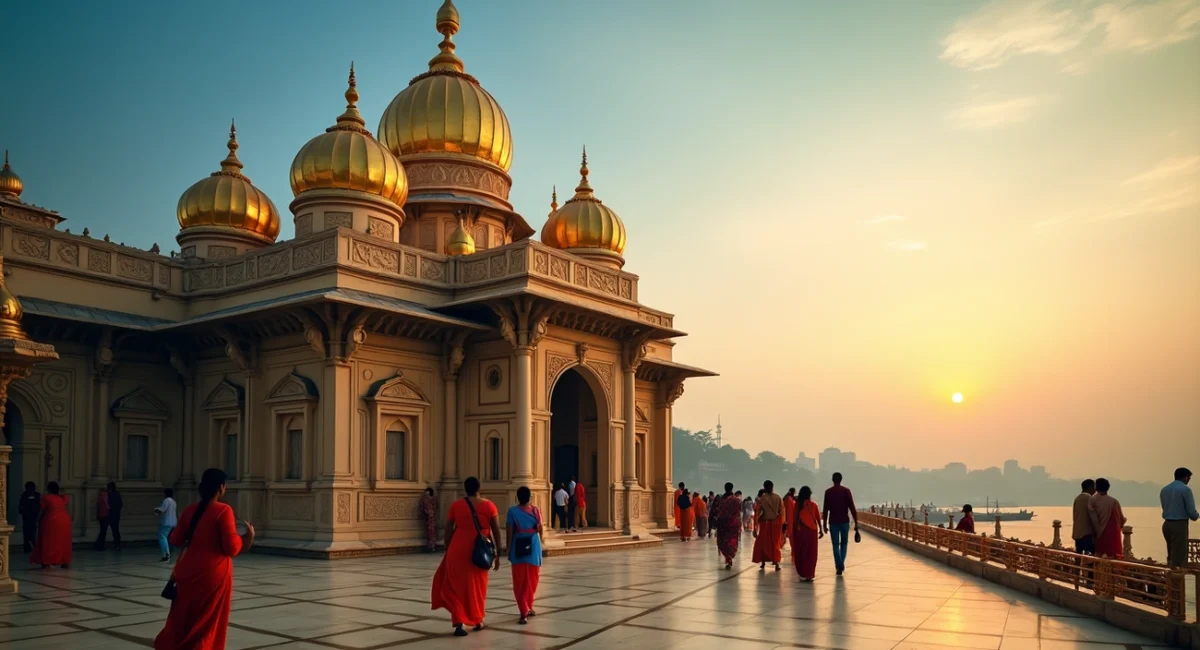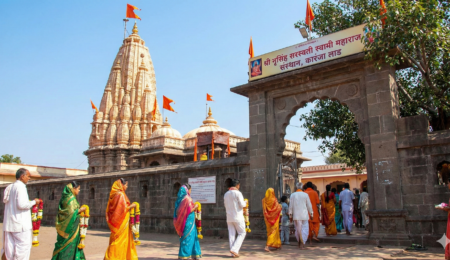Sacred Stories: Your Essential Guide to Kashi Vishwanath Temple in 2025
Kashi Vishwanath Temple
The Kashi Vishwanath Temple welcomes an astounding 45,000 pilgrims daily, with visitor numbers swelling to a million during festivals. As one of the twelve revered Jyotirlingas in Hinduism, this sacred site has become a spiritual magnet that has attracted over 100 million tourists since the inauguration of the Kashi Vishwanath Corridor in December 2021.
Located on the western bank of the holy Ganges River in Varanasi, this temple is dedicated to Lord Shiva, who is worshiped here as Vishwanath or “Lord of the Universe.” We often refer to it as the “Golden Temple” because of its magnificent gold-plated spires and domes. The current structure, built in 1780 by Maratha queen Ahilyabai Holkar, houses a smooth black stone lingam standing 2 feet high. Furthermore, the temple complex features numerous smaller shrines known for their intricate carvings and architectural beauty. In this comprehensive guide, we’ll explore the kashi vishwanath temple history, provide essential information about kashi vishwanath temple timings, and share everything you need to know when planning your visit from hotels in varanasi near kashi vishwanath temple to the spiritual significance of this ancient site.
The Sacred Legend Behind Kashi Vishwanath
Ancient Hindu texts reveal a fascinating cosmic drama behind the Kashi Vishwanath temple. This sacred site isn’t merely a place of worship but the embodiment of divine manifestation that has drawn devotees for millennia.
The story of Shiva’s infinite light
The origin of the kashi vishwanath temple story dates back to a time beyond human reckoning. According to Hindu scriptures, a heated argument erupted between Lord Brahma and Lord Vishnu about which of them was more powerful. To settle this divine dispute, Lord Shiva manifested as an endless pillar of radiant light, known as the Jyotirlinga, piercing both the heavens and earth.
This magnificent column of light appeared precisely where the Kashi Vishwanath temple stands today, marking Varanasi as the site of the first Jyotirlinga to ever manifest. Consequently, this sacred location became known as Vishweshwara or Vishwanath – “the Ruler of the Universe” – highlighting Shiva’s supreme position in the cosmic hierarchy.
The role of Vishnu and Brahma in the legend
Determined to find the pillar’s boundaries, Vishnu transformed into a boar (Varaha) and burrowed deep into the earth, while Brahma took the form of a swan and soared toward the heavens. Despite their extensive search, neither could locate the ends of this infinite column.
Upon returning, Vishnu honestly admitted his failure to find the pillar’s base. Brahma, however, falsely claimed to have discovered its top, even producing a ketaki flower as false evidence. Seeing through this deception, Lord Shiva punished Brahma by cutting off his fifth head and decreed that he would rarely be worshiped on earth. Conversely, Vishnu was blessed for his truthfulness and granted equal veneration alongside Shiva throughout the ages.
Why Varanasi is considered the city of liberation
The divine significance of this event established Kashi as a special spiritual nexus. In fact, Hindu tradition holds that dying in Varanasi and being cremated along the Ganges offers moksha – liberation from the cycle of rebirth. This belief stems from Lord Shiva’s constant presence in the city.
Essentially, Kashi is considered older than history itself. The city was personally ordained by Shiva as his earthly abode, making it the ultimate pilgrimage destination. The Kashi Vishwanath Jyotirlinga embodies this eternal connection, promising that anyone who beholds it comes closer to spiritual freedom.
Additionally, Hindus believe that the merits earned by visiting all other Jyotirlingas throughout India can be attained through a single visit to the Kashi Vishwanath temple, underscoring its paramount importance in Hindu cosmology.
A Timeline of Destruction and Rebirth
The kashi vishwanath temple history is marked by cycles of destruction and renewal, making it a symbol of Hindu resilience across centuries.
Ancient roots and early temples
The original Kashi Vishwanath Temple, initially known as Adi Vishveshwar Temple, dates back approximately 2,000 years. References to this sacred shrine appear in ancient Hindu texts including the Skanda Purana, Shiva Purana, and Mahabharata. This ancient temple established Varanasi as a spiritual nucleus long before recorded history, laying the foundation for the site’s enduring significance.
Mughal invasions and temple demolitions
The temple’s first recorded destruction came in 1194 CE when Qutbuddin Aibak’s forces demolished it during the conquest of Kannauj. Subsequently, a Gujarati merchant funded its reconstruction during Sultan Iltutmish’s reign (1211-1266). This resurrection proved short-lived as the temple faced demolition again under Mahmud Sharqi in the mid-15th century. Later, Sikandar Lodi ordered another destruction between 1489-1517.
Throughout the Mughal era, the temple experienced brief periods of revival. Raja Man Singh initiated rebuilding during Emperor Akbar’s reign, with Raja Todar Mal furthering reconstruction in 1585. Nevertheless, in 1669, Emperor Aurangzeb commanded the temple’s demolition and established the Gyanvapi Mosque atop its foundation. Remarkably, remnants of the original temple remain visible in the mosque’s foundation and columns.
Reconstruction by Ahilyabai Holkar and others
The present temple structure emerged in 1780 through the vision of Ahilyabai Holkar, the remarkable queen of Indore. She undertook this sacred project with personal resources between 1777-1780. Additionally, in the 19th century, Maharaja Ranjit Singh of Punjab enhanced the temple’s splendor by donating one ton of gold to plate its dome.
The 2021 Kashi Vishwanath Corridor project
Prime Minister Narendra Modi inaugurated the ambitious Kashi Vishwanath Corridor on December 13, 2021. This transformative project, costing approximately ₹900 crore, created a direct pathway from the temple to the Ganges River. Fascinatingly, during construction, workers uncovered more than 40 ancient temples that had been buried for centuries. These historical treasures were carefully restored while maintaining their original structures.
Inside the Temple Complex: What to Expect
Stepping into the Kashi Vishwanath temple complex feels like entering a realm where time stands still. This sacred space, constructed in the Nagara style of temple architecture prevalent in northern India, offers visitors a profound spiritual experience across its many sanctums and shrines.
Main sanctum and the Jyotirlinga
At the heart of this quadrangular temple lies the revered Jyotirlinga—a dark brown stone enshrined in the Sanctum Sanctorum (Garbha Griha). This sacred lingam, representing Lord Shiva, measures 60 cm in height and 90 cm in circumference, placed majestically on a silver altar. The inner walls of the sanctum sanctorum were recently adorned with 37 kg of gold, creating a dazzling backdrop for the divine presence.
Gyan Vapi well and its significance
To the north of the main temple sits the mystical Gyan Vapi (Well of Wisdom). This ancient well holds tremendous spiritual significance—legend narrates that when Aurangzeb planned to destroy the temple, a priest jumped into this well with the original Shiva lingam to protect it from desecration. Hindu texts mention that drinking water from this well grants freedom from the cycle of rebirth, making it a vital pilgrimage spot within the complex.
Other shrines within the complex
The main temple is surrounded by smaller shrines dedicated to various deities, creating a divine ecosystem. These include temples for Kaal Bhairav (Shiva’s fierce guardian form), Kartikeya, Avimukteshwara, Vishnu, Ganesha, Avimukteshwara, Sanishwara, Dhandapani, Vinayaka, and Virupaksha Gauri among others.
Architecture and gold-plated domes
The temple structure features three distinct parts: a 15.5-meter-high spire, a gold dome, and a gold spire atop Lord Vishwanath’s shrine carrying a flag and trident. In 1835, Maharaja Ranjit Singh donated approximately one ton of gold for the temple’s domes. More recently, in 2021, an additional 23 kg of gold was used to plate the lower portion of the dome and door frames.
Kashi Vishwanath temple photos: what you’ll see
Visitors capturing kashi vishwanath temple photos will notice the Sabha Griha (congregation hall) leading to the inner sanctum, intricate carvings depicting mythological scenes, and the magnificent 7-foot-high Nandi bull statue facing the temple. The gold-covered spires create an awe-inspiring sight that shines brilliantly in the sunlight.
Planning Your Visit in 2025
Pilgrimages require careful planning, especially to a site as revered as the Kashi Vishwanath Temple. With millions visiting annually, knowing the practical details will help maximize your spiritual experience.
Kashi Vishwanath temple timings and aarti schedule
The temple opens daily at 2:30 AM and closes at 11:00 PM. For an immersive experience, participate in one of the five daily aartis:
- Mangala Aarti: 3:00 AM – 4:00 AM
- Bhog Aarti: 11:15 AM – 12:20 PM
- Sandhya/Saptarishi Aarti: 7:00 PM – 8:15 PM
- Shringar Aarti: 9:00 PM – 10:15 PM
- Shayan Aarti: 10:30 PM – 11:00 PM
During Mahakumbh 2025 (January 13 to February 12), these timings will adjust slightly, with Mangala Aarti beginning at 2:45 AM.
Darshan types and ticket options
For a more convenient experience, consider these options:
- General Darshan: Free, available from 4:00 AM to 11:00 AM and 12:00 PM to 7:00 PM
- Sugam Darshan: ₹250, allows faster access from 6:00 AM to 6:00 PM
- Special Rudrabhishek: Various options from ₹450 to ₹57,100 depending on complexity
Hotels in Varanasi near Kashi Vishwanath temple
Several well-rated accommodations surround the temple, including Southern Grand Kashi, Mahant Ji Residency, and Golden Lodge. Most hotels offer free Wi-Fi, 24-hour front desk service, and are within walking distance of the temple complex.
How to reach: Varanasi railway station to temple distance
The temple is approximately 3 kilometers from Varanasi Junction (Cantt) Railway Station. Other distances include:
- Mauduadih Railway Station: 2.5 km
- Kashi Railway Station: 2 km
From these stations, auto-rickshaws (₹50-₹100) or cycle rickshaws (₹30-₹60) will drop you at Godowlia Chowk, after which you’ll walk through Vishwanath Gali to reach the temple.
Tips for a smooth spiritual experience
Visitors must cover their arms and legs, although traditional Indian attire isn’t mandatory. Electronic devices, including phones and cameras, aren’t permitted inside, yet lockers are available for a nominal fee. Given its immense popularity, visiting early morning or on weekdays ensures a less crowded experience.
Conclusion
Throughout centuries, Kashi Vishwanath Temple has endured as a testament to unwavering faith and spiritual resilience. From its cosmic origins as Shiva’s infinite pillar of light to its multiple destructions and resurrections, this sacred site truly embodies the eternal nature of Hindu devotion. Certainly, the temple’s magnificent architecture, gold-plated domes, and the revered Jyotirlinga continue to awe millions of visitors each year.
Planning your visit carefully will significantly enhance your spiritual experience. The expanded corridor project completed in 2021 has undoubtedly transformed accessibility while uncovering hidden historical treasures. Meanwhile, the various darshan options cater to different preferences, whether you seek a free general experience or a more personalized ritual.
Above all, Kashi Vishwanath represents more than just a historical monument or religious site. This divine abode connects devotees to an ancient tradition where the veil between earthly existence and cosmic reality thins. Therefore, we recommend experiencing at least one of the five daily aartis to fully absorb the temple’s spiritual essence.
Finally, remember that visiting this temple places you within a sacred geography believed to grant liberation itself. The temple’s story—repeatedly destroyed yet always rising again—reminds us of faith’s enduring power and spiritual perseverance. When you stand before the Jyotirlinga in 2025, you’ll join countless pilgrims across millennia who have sought blessings at this cosmic intersection where Lord Shiva eternally dwells as the Universe’s ruler.




Leave a Comment